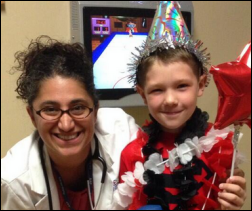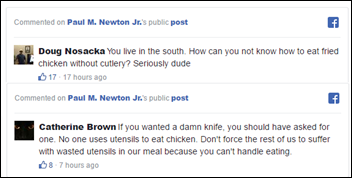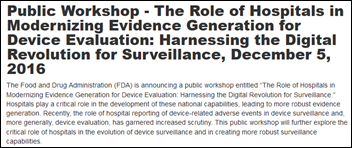News 11/23/16
Top News

UMass will pay $650,000 to settle HHS OCR HIPAA charges over a 2013 Trojan malware infection of a single workstation at its Center for Language, Speech, and Hearing that exposed the information of the PHI of 1,670 people.
OCR found that UMass had chosen a “hybrid” status — which requires it to designate in writing which of its components perform HIPAA-covered functions and which do not – but had failed to list the Center and some other components. UMass also failed to implement a firewall at the Center and had not performed a risk analysis at the time of the incident.
HIStalk Announcements and Requests

ST Advisors donated $500 to my DonorsChoose fund as part of their annual charitable giving, which through the magic of matching money funded these classroom projects:
- Strategic thinking, economics, and entrepreneurship games for Mrs. D’s middle school gifted class in Springdale, AR.
- Robotics programming kits for Mrs. F’s STEM high school class in Lincoln, KS.
- A microscope and other science materials for Mrs. M’s third grade class in Newport News, VA.
- A document camera for Mrs. R’s second grade English as a second language class in Englewood, NJ.
- Math manipulatives for Mrs. O’s second grade class in Kansas City, MO.
- A programmable robotics kit for Mrs. R’s third grade class in Brooklyn, NY.
- Headphones for Mrs. M’s school library in Bronx, NY.
- A Chromebook for Mr. G’s high school class in Bluejacket, OK.
- Math manipulatives for Ms. P’s middle school class in New Orleans, LA.
In addition, reader Bill sent a nice note and donation that funded a Kindle Fire and headphones for Ms. W’s kindergarten class in Los Angeles, CA.
I have another donation or two that I’ll apply later this week. Thanks to everyone who supports STEM learning in our schools. Watch this space for photos and teacher reports. I know the teachers are excited because I received emails from all of them within a few of hours of funding their projects, such as this one from Ms. W:
What an awesome way to start the day to know that an important project was funded by an awesome donor! Thank you from the bottom of my heart for your very generous donation! My students will be so excited to hear this news! They are so fired up about protecting the environment. This project will help further ignite that passion! Have an amazing and warm Thanksgiving.
Webinars
December 6 (Tuesday) 1:00 ET. “Get Ready for Blockchain’s Disruption.” Sponsored by PokitDok. Presenter: Theodore Tanner, Jr., co-founder and CTO, PokitDok. EHR-to-EHR data exchange alone can’t support healthcare’s move to value-based care and its increased consumer focus. Blockchain will disrupt the interoperability status quo with its capability to support a seamless healthcare experience by centralizing, securing, and orchestrating disparate information. Attendees of this webinar will be able to confidently describe how blockchain works technically, how it’s being used, and the healthcare opportunities it creates. They will also get a preview of DokChain, the first-ever running implementation of blockchain in healthcare.
December 7 (Wednesday) 1:00 ET. “Charting a Course to Digital Transformation – Start Your Journey with a Map and Compass.” Sponsored by Sutherland Healthcare Solutions. Presenters: Jack Phillips, CEO, International Institute for Analytics; Graham Hughes, MD, CEO, Sutherland Healthcare Solutions. The digital era is disrupting every industry and healthcare is no exception. Emerging technologies will introduce challenges and opportunities to transform operations and raise the bar of consumer experience. Success in this new era requires a new way of thinking, new skills, and new technologies to help your organization embrace digital health. In this webinar, we’ll demonstrate how to measure your organization’s analytics maturity and design a strategy to digital transformation.
Acquisitions, Funding, Business, and Stock
Oracle acquires domain name services provider Dyn, which was the subject of an October 21 distributed denial-of-service attack that rendered major websites unavailable to much of North America and Europe, for a rumored $600 million. Ironically, Dyn serves as the authority on Internet downtime and data blocking by monitoring web traffic and offering companies a rerouting service to make sure their visitors get through.
Symantec will acquire consumer identity protection LifeLock for $2.3 billion. LifeLock has paid more than $100 million in FTC fines for false advertising and reports found that its previous CEO, who was featured in endless ads listing his Social Security number with a challenge to hackers to try to steal his identity, was found to have had that identity stolen at least 13 times. At one point, the company’s main way of trying to prevent fraud was to place a red flag every 90 days on the credit files of its subscribers (who pay from $10 to $30 per month) as though someone might have compromised their accounts, with its reps calling Experian up to 15,000 times per day on their toll-free number and filing the same fraud alert that consumers could have requested on their own at no charge. Experian, which offers a competing service, sued and won.
Sales

Main Line Health (PA) selects Bernoulli for medical device integration as it transitions to Epic.

Spectrum Health (MI) chooses MModal for speech-driven clinical documentation.
In England, Royal Free London NHS Foundation Trust signs a five-year agreement for the Streams acute kidney injury event notification system from Google-owned DeepMind.
People

Canada-based mental health software provider Ehave hires Prateek Dwivedi (University Health Network) as president and CEO.
Announcements and Implementations
HIMSS and CHIME form HMISS-CHIME International, which will work together on their existing programs outside of North America. That raised my curiosity about CHIME’s finances. Its recent financial report shows total revenue of $6.5 million, of which $1.7 million came from conferences and sponsorship, $480,000 from dues, and $4 million from grants from what is labeled “Collegehlth Mgmt Exec Foundation,” which I assume is where the vendor checks are collected. There’s also the for-profit CHIME Technologies, which sells speaker services and provides vendors with advisory groups. CEO Russell Branzell earned $437,000 and his two EVPs made $162,000 each.

In Ireland, Cork University Maternity Hospital will go live on Cerner next week, with all 17 of the country’s hospitals expected to be live on Cerner by the end of 2017. Following that is the rollout of a single national EHR for oncology hospitals and another for acute care hospitals if funds are approved. Cerner is also providing national laboratory information system. Ireland prepared for single health record by implementing a universal patient identifier in August.
A new Peer60 report finds that 81 percent of respondents create patient reports using radiology speech recognition vs. the 12 percent that still send off dictation for transcription, with that number jumping to 96 percent of high-volume sites. Nuance was used by 85 percent of respondents, with the small remainder being divided among MModal, Dolbey, and Agfa. Nearly 75 percent of sites that aren’t already using speech recognition plan to do so, with the only holdouts being smaller sites. Net Promoter Scores are fairly high, making the replacement market unattractive.

The Mount Sinai Hospital (NY) goes live on a clinical research VNA from Vital Images that offers researchers a de-identified view of the fully detailed patient data used by clinicians on the same system.

Hardeep Singh, MD, MPH and the Houston VA Patient Safety Center win the VA’s research impact award for their work on delayed diagnoses, delayed test follow-up, and EHR safety.
Government and Politics
HHS Secretary Sylvia Burwell warns that a “repeal and replace” approach to the Affordable Care Act that would require years to offer a replacement program is really a repeal since it will cause collapse of the exchanges as the remaining insurer participants would pull out in 2018 in the uncertainty about what’s next. It would also leave 20 million people without insurance. Burwell is concerned that signups during open enrollment through December 31 may suffer because people are confused that the program is going away on Inauguration Day. Meanwhile, President-Elect Trump’s YouTube video in which he describes his highest priorities did not include repealing Obamacare, which he previously promised would happen the day he took office.
Technology

Drug maker Novartis says its Alcon eye care division will miss its goal of performing clinical trials on Google-designed smart contact lenses that can correct far-sightedness and measure blood glucose levels.
Other

The Wall Street Journal profiles the “fentanyl billionaire” whose company, Insys Therapeutics, is charged with bribing doctors to overuse its drug. John Kapoor, PhD, who’s worth around $2 billion, made his first fortune by spending $50,000 to buy a drug company selling an old AIDS drug, after which he quadrupled its price and netted $100 million when he sold the company. He then started Insys, which hired salespeople he called PhDs (poor, hungry, and dumb) who were paid little in base salary but who received a cut of every prescription issued by their doctor-clients, encouraging the reps to push high doses and large quantities. Two Alabama doctors are charged with making $40 million in illicit gains by prescribing $4.9 million worth of the drug for their Medicare patients alone in 2013-2014, also earning $271,000 in “speaking fees” from the drug company and millions more by having the prescriptions filled at a pharmacy they owned. One of the company’s reps, who was hired as a kickback to the doctor who confessed “a certain affection” for her, made $700,000 in two years from just the prescriptions written by the two doctors.

Stat ponders why President-Elect Trump recently met with drug billionaire Patrick Soon-Shiong, who is possibly under consideration to privatize Vice-President Biden’s cancer moonshot (which Soon-Shiong co-opted in forming his own Cancer MoonShot 2020 that mostly involves drug companies). Stat notes that not everyone is a Soon-Shiong fan, quoting a geneticist who summarizes, “A hype merchant propping up a lucrative empire with almost no real substance.” NantHealth shares have dropped 36 percent since their June 2016 IPO, while those of NantKwest are down around 75 percent since the company went public in July 2015.
In England, an NHS trust IT director pleads guilty to accepting a bribe to issue an ED software contract to the company of a local man who has also pled guilty.

ED physician Keith Pochick, MD pens a great, poetic opinion piece titled “Handheld electronic devices are the thieves of our meaningful moments,” describing a conference’s challenge to disconnect attendees from their smartphones:
On the second day, he invited us to turn off our handheld devices and put them into a basket at the front of the room. Most of us were able to do it, although quite a few participants needed to peek at their lifelines during breaks to ensure that the world was still spinning. Each of our respective loved ones knew exactly where we were, and would have had no trouble contacting us, yet the thought of “de-vicing” initially brought an incredible amount of angst. As the final two days of the conference developed, it became more and more liberating for me to be free from the chains of my digital master. While the conference wound down, we were each asked to list a few specific changes we’d make to enrich our lives and break behavior patterns which we believed were holding us back. I obviously couldn’t help but consider how many meaningful moments my constant accessibility and connectedness were stealing from me. I had become a slave to email, text messaging, instant Internet and YouTube access, and Facebook.
Cleveland Clinic CEO Toby Cosgrove disputes the many studies showing that hospital consolidation raises prices via their increased market power, saying instead that hospital mergers will prevent struggling facilities from closing by improving their efficiency. He also says that insurance must remain available for the 20 million people who buy theirs via the exchanges to prevent hospitals from having “major economic problems.”
New York-Presbyterian Hospital gave its former $3 million per year president another $6.4 million in severance when in September 2015 he abruptly resigned after having an extramarital affair.

Upworthy profiles “hippie turned doctor” Larry Brilliant, MD, MPH, who was motivated as one of only 60 attendees at a 1962, six-hour Martin Luther King, Jr. speech to later help cure smallpox, create the Seva eye charity that has restored sight to 4 million people, win a TED prize, and fight global pandemics. Brilliant’s just-released book is titled “Sometimes Brilliant: The Impossible Adventure of a Spiritual Seeker and Visionary Physician Who Helped Conquer the Worst Disease in History.” From his 2013 commencement speech to the Harvard School of Public Health:
As for my generation of young radicals, we had prejudged a mostly conservative profession, assuming they couldn’t be good doctors for being out of touch with the great social upheaval of the time, for not understanding the needs of the marginalized, not seeing the patterns and linkages between disease and poverty, the relationship between social justice and life expectancy, and how the battle then as now was about dignity and human rights. And here is the point as you go forward. Somehow, these two sides of our national health debate—one outward looking at social justice and inclusion and one inward looking inward at high quality patient care that is exclusionary—met then and must meet now on sacred ground, sharing the profound obligation and great joy of improving the health of the people …
Imagine that arc of history that Martin Luther King inspired is right here with us. The arc of the universe needs your help to bend it towards justice. It will not happen on its own. The arc of history will not bend towards justice without you bending it. Public health needs you to insure health for all. Seize that history. Bend that arc. I want you to leap up, to jump up and grab that arc of history with both hands, and yank it down, twist it, and bend it. Bend it towards fairness, bend it towards better health for all, bend it towards justice. That’s your noble calling of public health.
Sponsor Updates
- Huntzinger Management Group announces a strategic partnership with DCCS Consulting.
- GetWellNetwork announces that more than 100 hospitals are using its Marbella data collection tool for rounding and collecting patient and staff feedback, with 20 new customers added since July 2016.
- HCI Group posts a podcast titled “EMR Training: What Goes IN to Achieving High Levels of Adoption.”
- Sutherland Healthcare Solutions announces its investments in healthcare analytics that include development of its SmartHealthSolutions portfolio, the acquisition by its parent company of big data analytics firm Nuevora, and a partnership with IIA.
- Optimum Healthcare IT is named a top 10 RCM provider.
- Baptist Health South Florida realizes $45 million in increased appropriate reimbursement following its implementation of Nuance Clinical Documentation Improvement.
Blog Posts
- Diabetes: Top Three Medication Safety Concerns (Wolters Kluwer)
- Infusion Errors Top the 2017 ECRI Hazards Report (Iatric Systems)
- Meditech’s Web EHR Brings Integration Value to Wilma N. Vázquez Medical Center (Meditech)
Contacts
Mr. H, Lorre, Jennifer, Dr. Jayne, Lt. Dan.
More news: HIStalk Practice, HIStalk Connect.
Get HIStalk updates. Send news or rumors.
Contact us.


















































































































































































































Merry Christmas and a Happy New Year to the HIStalk crowd. I wish you the joys of the season!